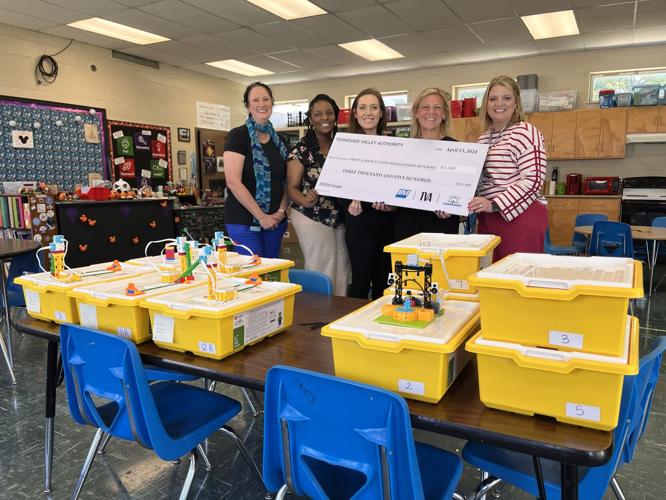The Tennessee Valley Authority, in partnership with Bicentennial Volunteers Inc., recently presented TVA STEM Classroom Grants to Athens City and Limestone County schools.
Since 2018, TVA/BVI has provided almost $5 million in STEM (Science, Technology, Engineering, Mathematics) grants to support science, technology, engineering, and math education projects for almost 600,000 students across the seven-state TVA region.
This year’s award winners: Athens Renaissance School received a $5,000 grant.
The award will incorporate aviation and drone technology in the classroom. Students gain exposure to agriculture, geography, videography and the environment through project-based learning incorporating math, science, data interpretation and programming.
Description of the award from the school: “The purpose of Dronagogy in the Community is to help students see math and science from a different perspective. This project will allow students to learn through project-based experiences. Dronagogy in the Community helps take our existing PBL projects to the next level. Students will work with community leaders to assist with finding solutions for current issues within our community. Through project-based learning, students will design action plans and experiments that will contribute to solving the problems. Students will explore coding applications using drone technology. The drones will offer different advantages ranging from aerial exploration to the development of artificial intelligence. It also gives students the opportunity to see coding applications through real-world experiences. Students will acquire essential skills through Dronagogy in the Community such as teamwork, problem-solving, collaboration, and perseverance. These skills and the effort they take in solving the problems will help students become productive global citizens in their community. Overall, this will help strengthen the connection between families, schools, and communities.”
SPARK Academy at Cowart Elementary received a $3,500 grant.
The school purchased new 3D printers with its grant. Students use CAD and 3D printing for projects such as mission patches, constellation disks, name tags and even snowflake ornaments.
Description of the award from teacher Jennifer Kennedy: “Each grade level will complete an age-appropriate project that leads to creating a unique artifact that can be printed on our 3D printer and then taken home. Kindergarten students create a key tag that has a sample of their handwriting at the beginning of the school year. First-graders design their own constellations and print a disk that they can put in front of a flashlight and shine their constellations on the wall. Second-graders learn about lines of symmetry by creating symmetrical snowflakes and third graders design a backpack medallion that combines symbols of four things that are important to them.This project will replace our two older printers, purchased in 2017. One printer no longer works at all and the other prints only after great attention. To help keep costs down, I am able to use parts from the old printers, such as the flexible print bed, on the printers we purchase with the grant. These new printers will help us continue to provide 3D printing opportunities for our students for many years to come.”
HEART Academy at Julian Newman Elementary received a $3,500 grant.
The school utilized the $3,500 grant to purchase 10 Lego Education Spike kits to expose students to computer science, engineering, programming and debugging.
Description of the award from teacher Diane Trout: “Each grade level will complete an age-appropriate project that leads to creating a unique artifact that can be printed on our 3D printer and then taken home. Kindergarten students create a key tag that has a sample of their handwriting at the beginning of the school year. First-graders design their own constellations and print a disk that they can put in front of a flashlight and shine their constellations on the wall. Second-graders learn about lines of symmetry by creating symmetrical snowflakes, and third graders design a backpack medallion that combines symbols of four things that are important to them.This project will replace our two older printers, purchased in 2017. One printer no longer works at all and the other prints only after great attention. To help keep costs down, I am able to use parts from the old printers, such as the flexible print bed, on the printers we purchase with the grant. These new printers will help us continue to provide 3D printing opportunities for our students for many years to come.”
Athens Intermediate School Gifted Program received a $5,000 grant.
The program purchased LulzBot Mini 3D printers and spools of filament with the $5,000 grant. Students utilize critical thinking and creativity to solve real-world problems and bring their solutions to fruition through 3D printing.
Description of the award from teacher Eryn Mitchell: “Our gifted students do a lot of brainstorming and planning for ways to solve common community problems. However, we’re often not able to see it through and actually create or implement the solution to see what the outcome may be. I would like to purchase three 3D printers to allow my students to see their plans come to life. This could be a prototype of a new invention they have come up with, a working hose fitting for an irrigation system, or a model of a school security device they think could help in an emergency. The options are limitless and my students always blow me away with the ideas they come up with to solve common problems we often don’t know how to solve with typical solutions. This opens a door to allow students to take control of their own learning and the problems that effect their lives and our community.”
Ardmore High School received a $5,000 grant.
Description of the award from teacher Tamara Hillard: “This generation is continually bombarded with highly politicized opinions regarding energy usage and alternatives. Since they will soon be tasked with energy and environmental decisions, they need real information in order to best weigh the pros and cons of various energy alternatives. They need an understanding of the underlying mechanics of energy conversion if they are to sift through the misinformation and draw informed conclusions. To help students gain a strong background in the science of energy conversion, we plan to purchase materials to help students evaluate (and in some cases build) energy-harnessing models such as wind, water, biofuel, and solar. Through creating their own small-scale models and making concrete observations, they gain the base knowledge that they will need in order to be our future decision makers. Students will create presentations and displays using evidence from their findings. As these students complete their hands-on projects and presentations, which will be shared with the student body, they will help our entire community to be better informed about how different energy alternatives actually work and their impact on the environment.”
Blue Springs Elementary School received a $5,000 grant.
Description of the award from teacher Pam Fowler: “Blue Bots of Happiness will use the Ozobot Evo set to foster hands-on learning about robotics, math and programming in a fun way to keep students engaged. This will allow students not only in the gifted classroom but other general education classroom to be introduced to the world of technology and robotics. As we are an agricultural community bringing hydroponics in with the robots is a perfect fit and a pipeline for future career studies.”
West Limestone High School received a $5,000 grant.
Description of the award from Nissi Clingan: “I would love to create a simulated work place for my high school students in family and consumer science. They would have the opportunity to create a business from scratch as we learn all of the needed skills including budgeting, recipe building, marketing design skills, apply principles of measurement, portion control, conversions, food cost analysis and control, menu terminology, and menu pricing to menu planning. Students will develop and plan a bakery/coffee shop storefront, logo, menu, interior layout, and specialty item for their bakery. Create a 3D bakery layout in a shoebox. Explore and complete a business license application. Develop a recipe and price their specialty bakery item. Make a salt dough model of their specialty item. They will incorporate STEM into this assignment through the exploration and trial of different recipes, calculations to determine profit margin and create menu pricing based off costs, engineering through the creation of a 3D visual of their storefront along with creating a business based on the needs of their community. Technology will be used throughout the project from the needed espresso/coffee machines, various cooking equipment.”
Creekside Primary School received a $2,500 award.
Description of the award from teacher Aly Rish: “Every year students study the science behind sound production in the music classroom. With this funding, I can provide students with hands on manipulatives that will create a deeper and more visual understanding of how sound is created. While students are familiar with learning about sound, they are not as familiar with how that science is applicable to the various careers that utilize an understanding of sound. Over the course of this project all students will engage in experiments and projects that facilitate an exploration into the science of sound. The anticipated results of this project will be for students to identify careers in both musical and non-musical settings that utilize sound, describe how sound is produced and travels, and to recognize how music and sound are integrated with STEM. “











Commented
Sorry, there are no recent results for popular commented articles.